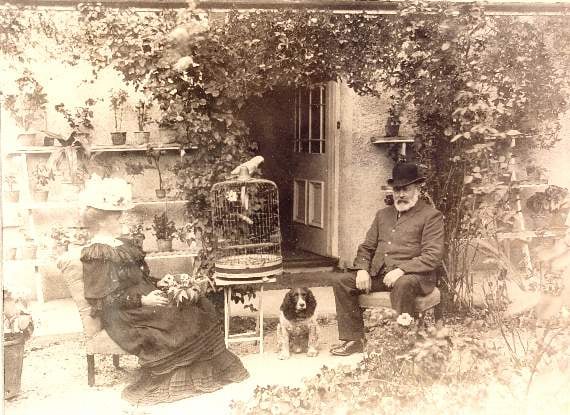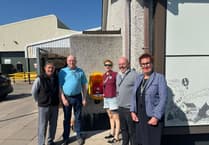Journalist Juliette Bowers looks back at the rich history of daffodils from the Tamar Valley
HERALDERS of spring, daffodils dotting our Tamar Valley landscape with glorious colour uplift our winter-weary spirits like no other flowers.
In its narrow winding lanes we are greeted by a myriad of their bright, cheerful faces peeping from hedgerows, verges and walls and it is hard to resist their bright, charismatic beauty.
I have always admired these beguiling blooms, but it was not until I moved to Bere Ferrers, West Devon five years ago, that I really started to appreciate their once vital importance in the Tamar Valley economy.
Since February, as I ramble weekly with the Tamar Valley Walk and Talk group, I frequently espy daffodils randomly presenting their evidence of market gardening’s bygone age. Digging deeper, I am amazed to learn how many people’s lives have been touched by commercial flower and fruit growing.
In the latter half of the 19th century, as mines were closing down, the industry was becoming established in the Tamar Valley and developed and prospered up to the 1960s — on the Cornish side between Gunnislake and Botus Fleming, on the Devon side predominantly the Bere Peninsula and, to a lesser degree, Tamerton Foliot.
Local markets, such as Devonport, Plymouth, had thrived for many years, but what really put the area on the map was a St Dominic man called James Walter Lawry, who in 1862 visited Covent Garden and was surprised to discover no outdoor grown strawberries — yet Tamar Valley’s late varieties were just coming in. So he quadrupled his acreage with both strawberries and daffodils and the following year sent them by steamer along the Tamar to Plymouth and up to London. Other growers in the area followed suit and the valley’s industry started to flourish.
Impact of the railway
Rail transport revolutionised market gardening. Brunel’s Great Western Railway arrived in Plymouth in 1849 and, ten years later, Cornwall, with the building of Saltash Bridge.
Initially, Bere Peninsula growers sent their produce to Plymouth station by boat and cart, but with the arrival of the London and South Western Railway at Bere Alston and Bere Ferrers, they, too, were able to despatch their produce to the city within a few hours.
Daffodils expert Dr Frances Howard, of Weir Quay, who is the vice-president of Bere Ferrers Spring Flower Show and show secretary of Bere Alston Show, said: ‘All this coincided with the great surge in hybridisation, when species of daffodils went from very few to hundreds and the thousands of today’.
Growers grew ones such as Emperor, introduced in 1865, and Empress, 1869, because they were hardy. Interestingly, one of the best known market boats, which collected produce from every main quay either side of the Tamar, was called The Empress.
Frances and fellow daffodils enthusiast, David Pearce, have produced a glossy, double-sided card, entitled: Historical Daffodils in the Tamar Valley Hedges, which illustrates trumpets, bi-colours, doubles and whites over the centuries.
Before the Great Fire of London in 1666 there were only three daffodils known to have been growing in the area — Maximus Superbus, a big yellow trumpet, which would have been seen by Sir Francis Drake some 100 years earlier; Lent Lily, a medium yellow trumpet, as featured in the poem I Wandered Lonely As A Cloud by William Wordsworth (1770-1850) and Van Sion, ‘the great double daffodil’ of a Flemish man living in London in 1620.
Septimus Jackson
In the 1880s a man called Septimus Jackson found a strongly scented daffodil in the hedgerows near his home at Clamoak Farm, Weir Quay, and observed its long vase life. It was a sport of the ‘Whitsun Lily’ Pheasant’s Eye, which blooms in May, with snowy white petals swept back from a tiny yellow cup, edged in red. Realising its potential, he sent some to market and they were immediately popular. It took around 30 years to get enough bulbs to start commercial growing, but the ‘Tamar Valley double white’, as it became known, was the pride of the valley, being sent up to London markets in special blue tissue-lined boxes.
Septimus (the seventh son of 13 children) was the great-great grandfather of Bere Ferrers resident, Margaret Willmott. She said: ‘He was quite a celebrity in the area and when the first train came through in 1890 was privileged to be invited to ride on it.’
Margaret, who with husband Alan grows and sell plants including daffodils from their home, is approaching her 20th year as chairman of Bere Ferrers Spring Flower Show. Market gardening featured strongly on both sides of her family. Her father Richard (Septimus Jackson’s grandson) was treasurer of the show committee before her.
‘He had done it since I was knee-high to a grasshopper. I took over to continue the family connection,’ said Margaret, who remembers seeing 13-carriage freight trains packed with flowers and fruit en-route to London and other parts of the country.
Sadly, today the Tamar Valley double white is no longer evident because it reverts back to pheasant’s eye (the father of most flat white narcissi). Margaret and Frances Howard are among few people fortunate enough to retain some ‘double whites’ on their land.
One may be fortunate to see some at the Bere Ferrers Spring Show at the church hall on Saturday afternoon, April 8. Also among the usual spectacular daffodil varieties may well be the ‘Bere Peninsula’, registered in 1979 by bulb farmer and breeder, Dan du Plessis. Dan ran the business with brother, Peter (which when they retired in 1990 had 16 acres of daffodils and a collection of 800 varieties) and was vice-president of the Daffodil Society and a founder member of the Cornwall Area Bulb Growers’ Association.
Dan was among local daffodil experts who in the late 1990s helped the Cotehele’s head gardener, John Lanyon, identify daffodils left behind by market gardening and gave bulbs he had bred. There are believed to be some 250 varieties of daffodils and narcissi on the estate, including the old Tamar daffodils, which have subtler colours, such as creams with coral trumpets and lighter yellows.
Cotehele celebrates its breath-taking array of daffodils annually and this year a Daffodils Weekend is being held at the National Trust property on March 18 and 19.
Up to the First World War growers dug up daffodil bulbs after flowering and sterilised them to kill off their deadliest enemy, the eel worm, and replanted them ready for the following season. After WW1, Margaret Willmott’s grandfather, John Doidge, rented land at Hewton from the Earl of Mount Edgcumbe, clearing tree stumps from steep slopes down to the Tamar and planting daffodil bulbs and strawberries.
Margaret’s mother, Vera Jackson, 82, recalls: ‘At that time people would go mad about flowers. Dad grew a lot of ‘daffs’, such as Emperor, Fortune, King Alfred and double whites. In the mornings we used to go out on the hill, pick and bunch them, then drive the van up to Bere Alston station and they would go on the early afternoon train through to Waterloo by 6am the following morning’. (The London Markets included Covent Garden, Borough Market and Spitalfields).
Vera also recalls her mother, Nora, taking their blooms on the steamer from Hole’s Hole to Devonport market on Saturdays, along with vegetables, butter and eggs. Vera and sister Kathleen, now 101 and living in Bere Alston, remember bunching flowers during evenings of the Plymouth Blitz in 1941 when the sky lit up as bright as day.
When their father died in 1948, Vera continued running the farm with Nora for five years until she married Richard Jackson and went to live at New Park Farm, Bere Ferrers, her present home. She says ‘a few double whites still bloom in a big granite trough’ — a reminder of the good old days when Tamar Valley’s prized daffodils took the country by storm!
Heritage Lottery funds daffodils’ study
THE Second World War was a deadly turning point for older daffodil varieties. Those grown commercially fell victim to the war effort as Land Army girls tossed bulbs into hedges to make way for crops. The fields were depleted but left behind was our wonderful legacy of roadside blooms as we see them today!
Author Ted Sherrell, who writes the ‘Totally Ted’ column in the Times, said the Tamar Valley was a very tight-knit community. where many worked in the industry, so were inter-dependent.’
He is full of stories about his childhood on the farm. His family arrived in the area when his great-grandfather became a ‘hind’ — a farm manager at South Hooe Farm, Bere Alston. His parents, Harold and Ada, farmed 80 acres, about 12 of them devoted to daffodils, plus strawberries and other soft fruits, potatoes and barley. They also kept sheep and a few cows.
He said: ‘It was hard work on often steep terrain, which could only be worked by hand. My father employed five men all year round and up to a dozen women during harvesting. There were no tractors, only the use of cart horses.’
Ted’s brother, Stan, also farmed on the slopes near the River Tavy at Hole Farm, focusing mainly on dairy, sheep and barley growing. He still lives there today.
Daffodils expert Dr Frances Howard has been instrumental in recently helping the Tamar Valley Area of Outstanding Natural Beauty (AONB) achieve a £9,900 Heritage Lottery Grant for a historical study of daffodils on the Bere Peninsula. She believes that the Tamar Valley is probably the only place in the country where so many daffodil varieties have survived.
She said: ‘If you look, we have a living museum in our hedgerows; the footprint that time has left behind after the mining industry collapse in the 1860s. Daffodils and soft fruits helped to rebuild the livelihoods of so many people.’
Study project officer Lesley Strong wrote the lottery bid and said the ground-breaking project, ‘Heralds of Spring’, would be looking at the historic collection of daffodils within the landscape, focusing initially on the Bere Peninsula area.
Corrina Woodall, AONB manager, added: ‘Daffodils represent the strong heritage and horticultural legacy of the market gardening industry – hugely important to the sense of place of the Tamar Valley.’
Commercial daffodil and fruit growing thrived until the mid-1960s when Dr Beeching’s axe put an end to many rural railways; this, plus a combination of blight, pick-your-own farms and foreign imports. Tragically, today few growers are left on the Bere Peninsula; Channons (Sampson Channon, at Well Farm, used to be one of the biggest growers of “double whites” in the country) and the Schuttkackers, who still supply local shops.
Frances Howard said: ‘We are looking at the end of the large commercial growers and it is very important that our children and grandchildren know about them. Some of these daffodils have been here since Elizabeth 1 and we must teach them to cherish them’.
One person who remembers all the old varieties that her grandfather grew at South Ward Farm, Bere Alston, is Iris Snell, who lives in the village with husband John. She was born at North Ward Farm and when she was three her parents moved to Helston Farm, taking with them many of their daffodil bulbs. They farmed there until retiring in 1963.
Over the years Iris has built up a comprehensive collection of photographs and documents detailing her life, with maps showing flowers and fruit growing areas. She was a skilled florist and in 1984 won a marathon run by the East Cornwall Mine Rescue Group when she bunched 25,780 daffodils in 12 hours!
She told me: ‘If you had a shed full of double whites when you opened the door you would stand back, they were so overpowering. They would make your head ache.’
Iris, 82, remembers the exact times when different varieties of daffodils were picked — double whites were the second week of May. ‘Sometimes there weren’t many; they were very temperamental flowers, if there was not enough rain or too much, they just went brown. The weather had to be just right.’
Of various flowers grown commercially, she recalls roses, irises, anemones, lily-of-the valley and primroses –‘but the biggest market gardening was daffodils.’
During the war when daffodil bulbs had to be dug up, she said: ‘The Ministry of Food used to come round and check they were done.’
After the war she said newer varieties were planted, inspired by salesmen from Holland … and we all know their mastery in bulb cultivation!
Produce in great demand
IT’S sobering to think that at one time in the Tamar Valley there were 3,000 people working in the flower and fruit growing industry (as many as the combined populations of Bere Alston and Bere Ferrers today).
In 1957, a Mr George Cradick —one of the valley’s largest growers) — gave a lecture to the Tavistock branch of the Devonshire Association highlighting the scale of the Tamar Valley growing area. It was said to include 850 independent holdings, of between one and ten acres, employed approximately 3,000 full-time employees, the figure rising to between 8.000 and 10,000 during the flower and fruit season!
The produce was in great demand all over the country and the industry labour intensive and hard work. Vera Jackson recalls that at Lockeridge Farm, where her sister Kathleen lived, around 30 women were hired to pick daffodils, strawberries and other produce. On larger farms the figure could more than triple!
Iris Snell, of Bere Alston said women who picked at North Hooe and South Hooe farms had to walk three miles from the village, do a hard day’s work and then walk three miles home!
During the 1950s, on the other side of the valley at Bohetherick, a grower called Alfred Pengelly and his wife, Winifred, rented fields sloping down to the Tamar, living at ‘Tamar View’ in the village. Daughter Christine, the youngest of five children, told me: ‘I absolutely loved it — picking the daffodils and strawberries out in the fresh air. I felt so free!’
Fertile soil
Christine Teague, 68, is an artist teacher living in Lincolnshire, but her heart still lies in the Tamar Valley. She recalls the soil being ‘so fertile you could grow almost anything’ and ‘you never got a frost on the banks of the Tamar’.
She said: ‘The Tamar Valley double white was the main daffodil that lots of growers grew. The head of the flower was a lovely creamy white and it had a lovely scent. Sadly, a disease wiped out a lot of the old daffodils – it was in the soil.’
Alfred Pengelly also grew two strawberry crops a year; June/July and at Christmas. He had thousands of cloches and Christine said that being a family business it was ‘flat out’ getting them to market.
‘They had to be picked just right and somebody called to collect them from the end of Dad’s field and take them up to Gunnislake station, which used to be on the opposite side of the road. I remember the steam trains and getting up on the bridge and all the smoke and the smell from the train’, she said.
Strawberry crops, too, were ravaged by disease, but Christine said the introduction of ‘pick your own’ farms sounded the death knell for small market gardeners.
‘We couldn’t compete – the industry was declining and declining. It was sad for everybody in the valley.’
With relatives still living in Callington, Christine occasionally visits and is upset to see the fields where her father used to grow crops.
‘They look so neglected and sad, left unattended – it is just a waste of fertile soil. I hope somebody can bring it all back.’
Iris Snell’s husband, John, is a historian, who has written a study called Fruit and Flower Growing in the Tamar Valley. He worked for the railways for 46 years, starting as a clerk at Calstock on April 4, 1949 and over the years also worked at Gunnislake and Bere Alston. At the latter it was his job to relay to Waterloo details of all the produce loaded at each of the stations.
He writes: ‘When I started working, flowers occupied more acres than fruit. Flowers became more and more in demand due to birthdays, anniversaries etc. At this time it was estimated that some 500 acres were in bulb cultivation’.
John quotes an article from The Southern Railway Staff magazine, September 1949, which said: ‘The Tamar Valley growers have had a most successful season, both fruit and flowers being heavy. The following despatched from Gunnislake, Calstock, Bere Alston, Bere Ferrers and Tamerton Foliot: Boxes of flowers 138,228, boxes of fruit 240,564.’
John continues: ‘When I was a booking clerk at Bere Alston I would have to send a telegram to Waterloo station advising the amount of traffic coming forward. The advice would be sent around 6pm and the flower vans would arrive at Waterloo at 3.48am the following morning. Growers were allowed a weekly credit account and bills sent out on Fridays would be paid the following week’.
He refers to the Tamar Valley Growers’ Association, formed in the 1930s, which was one of the first growers’ co-operatives in the UK and took over the Thomas Westlake brickworks at Rose Hill, Calstock.
‘Growers had shares in the association and the building became ‘the Chip (Basket) Factory’, which provided boxes, chip baskets and paper for the growers’.
Now the factory site is a small housing development and, as John writes, the once kept fruit and flower growing areas ‘have returned to woodlands and fields — but during the Spring you can at times see daffodils…’
It must have been heart-breaking to witness this great industry’s demise. Today one can almost hear echoing around the Tamar Valley the ghostly sounds of growers busy at their work.
If you ever see daffodils growing there think of them as a perpetual tribute to all those who gave their lives to the industry!





Comments
This article has no comments yet. Be the first to leave a comment.